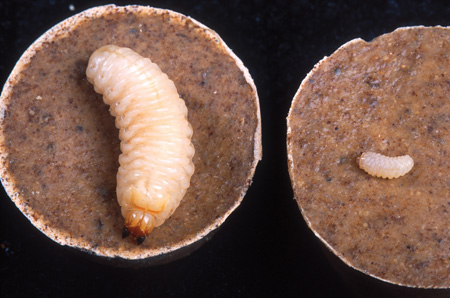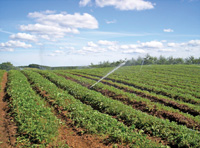
Features
Production
Research
Nematodes can help fight root weevils in strawberry plantings
strawberry producer Jackson Lore is a true believer
March 13, 2008 By Dan Woolley
Nova Scotia strawberry producer Jackson Lore is a true believer in the use of beneficial nematodes as a root weevil bio-control.
 |
| examples of root weevil larvae. Believe it or not, the one on the left is the younger specimen of the two. Photo courtesy of USDA-ARS |
Nova Scotia strawberry producer Jackson Lore is a true believer in the use of beneficial nematodes as a root weevil bio-control.
About 25 years ago, after clearing woodland to plant strawberries on his Shelburne County property, located in southwestern Nova Scotia, Lore made a shocking discovery. Following his first fruiting year, he discovered he had a chronic and very serious root weevil problem. In fact, his newly created strawberry plantings were infested with at least three weevil species native to Nova Scotia.
“Over the years, I have had more trouble with root weevil than anyone else in this room,” he once claimed to a gathering of Maritime berry producers.
His weevil problem was compounded by the location of his strawberry fields, which were surrounded on three sides by woodlands – a good source of weevils.
The only control option available to him was to spray the adult weevil following berry harvest in late July and early August in hopes of killing them before they laid their eggs. His root weevil problem was so serious, he had to follow that spraying practice every year. “If I hadn’t sprayed; I would have been wiped out.
“Once larvae are in the ground, you are done. You will have damage next year.”
Lore’s weevil problem was usually worse in his older fields. Even so, root weevil larvae could be found feeding on the roots of plants in his younger fields in early August. One year, the infestation was so severe Lore was forced to plough down one acre of a first year fruiting field.
 |
| Shelburne County, Nova Scotia, strawberry producer Jackson Lore has been using beneficial nematodes in his plantings for the past few years as a control for root weevil damage. Photos by Dan Woolley |
Inevitably, over time, Lore found his pesticide program was becoming less effective and, “even in the best of years, there was always some economic damage.” Multiple sprayings were not controlling the pest and the adults were starting to appear earlier in the season, thanks in part to a series of mild winters in the late 1990s. When weevils began to appear in early May, he realized they were now over-wintering as adults, laying their eggs earlier in the year, meaning an early season pesticide application was required. Unfortunately, in Canada there is no pesticide registered for early season control of root weevil. Lore decided it was time to move away from pesticide controls. He enrolled in some integrated pest management (IPM) programs and surfed the Internet in search of alternative control measures. On-line, he discovered the Dutch bio-control company Koppert, with a Canadian location in Scarborough, Ontario, which could provide Nova Scotia with next-day delivery of biological bio-controls. Through Koppert, he discovered the benefits of beneficial nematodes.
For his first trial with nematodes, Lore worked with the company and applied the bio-control on September 22. “We had excellent results,” he recalls. “Next year, there was no sign of weevil damage.”
As an insurance policy, he treated the entire farm with nematodes in September 2004 and found no crop damage the next year. “I have never found chemicals that work that well.”
Lore says the advantage to using nematodes as pest control agents is there is no lingering chemical residue, which improves his berries marketability to retailers and consumers. Nematodes are also safer for the grower, better for the environment and more efficient than conventional pesticides, he says, adding the nematodes will seek out the weevil larvae, there is no resistance problem and no negative influence on berry yield.
Lore says growers need to monitor their application of nematodes, remembering that timing and application techniques are important in successful weevil control. The recommended rate is one billion nematodes per acre, which costs about $300 an acre. They can be applied through the grower’s sprayer by removing its screens but Lore believes the best application method is through an irrigation system, either trickle or overhead.
 |
| Nematodes like a moist environment and need to be applied on a moist day or after the soil has been moistened. |
Nematodes like a moist environment and need to be applied on a moist day or after the soil has been moistened. The entire nematode package should be used and the solution needs to be mixed so the nematodes do not sink to the bottom of the sprayer tank, says Lore. The best soil temperature for application is around 20ÞC.
Scouting is also very important in weevil control. Growers should be looking for adults during the season, especially at night, since they are nocturnal eaters. Growers should also check berry roots for larvae in late August and early September. Nematodes need to be applied after the weevil lays its eggs and the larvae are in the ground, Lore explains, rather than before the weevil lays eggs, a common practice when using a chemical control program.
“You are better off to go with the early fall for the best bang for the buck.”
Nematode application can fail if they are applied at the wrong time, when the soil temperature is too cold or if using the wrong species of nematode. “Good application technique is crucial,” says Lore.
“(Nematodes are) an excellent tool for your IPM program. I feel bio-control will become the way of the future as long as you can keep your cost down.”
Print this page